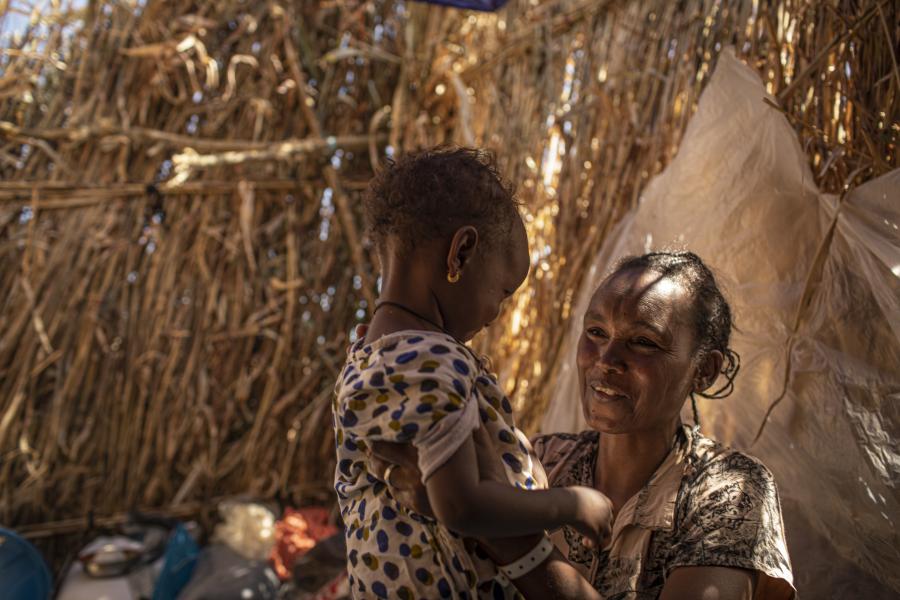2022 Year-end population figures
-
Refugees: 2.3 million South Sudanese refugees
-
IDPs: 1.5 million
-
Refugee returns: 151,300
2022 situation overview
The South Sudanese refugee population, the largest in the region, remains extremely vulnerable. At the end of 2022, there were 2.3 million South Sudanese refugees in camps, settlements, and urban areas in the Democratic Republic of the Congo, Ethiopia, Kenya, Sudan and Uganda, living in precarious conditions, exacerbated by the ongoing drought and food insecurity. After nearly a decade of conflict and despite efforts toward implementing the peace agreement, South Sudan continued to grapple with sporadic violence, economic instability and the devastating impact of massive flooding.
Armed conflict escalated in South Sudan’s Upper Nile state and displaced thousands of people internally and across borders. The armed conflict erupted in August in the village of Tonga in Upper Nile state, but violence then spread further in Upper Nile state, Unity state and northern parts of Jonglei state, displacing at least 20,000 people. In September 2022, UNHCR declared an internal Level 1 Emergency in South Sudan due to the combined impact on the civilian population of the Tonga conflict and the unabated flooding. This enabled UNHCR to quickly inject additional emergency resources for the needs of the growing number of IDPs in Upper Nile, Unity and northern parts of Jonglei, and to proactively prepare for further response measures. As part of this emergency response in South Sudan, UNHCR increased its protection services and assistance capacity, including through the Cash Plus approach. Cash Plus is a case management approach that looks at the needs of displaced people more holistically, and therefore integrates multi-purpose cash assistance with needed service provision, assistance to enable the use of the cash and/or to address additional basic services and assistance needs, in addition to proactive risk mitigation. It helps ensure that no one is left behind by identifying those most in need, vulnerable or at risk. UNHCR increased its mobile response capacity through additional boats to respond to the flooding emergency in key response areas in Unity and Upper Nile states.
The situation in South Sudan was extremely challenging in 2022. The Government had limited capacity to respond to humanitarian needs, and most IDPs, refugees and returnees were living in remote areas of a country that has limited connectivity and infrastructure, where roads are seasonally inaccessible due to heavy flooding.
While UNHCR did not promote or facilitate returns, close to 600,000 South Sudanese have spontaneously returned on their own since 2018, although some of the returns may have been pendular. In 2022, in response to the growing number of self-organized returns, UNHCR developed a solutions-oriented, area-based approach. This involves investing in medium- to long-term development and peace interventions in high-return areas, dubbed “Pockets of Hope”. Returnees and local communities in these areas benefit from enhanced living conditions and livelihood opportunities, strengthened local systems, and greater access to services through inclusive Government- and/or community-led projects.
Governments in the five countries of asylum were supported in their efforts to integrate South Sudanese refugees into national systems for social service delivery. Refugees and local communities were supported to boost their resilience by identifying and diversifying opportunities to earn a living. Nevertheless, with new refugees continuing to arrive in 2022, especially in Uganda, where 50,000 new South Sudanese refugees were received, host countries continued to grapple with limited resources for a situation that remained severely underfunded. Three of the main refugee hosting countries – Ethiopia, Sudan and Uganda – were highlighted in UNHCR’s Underfunded Report of 2022 as having limited resources to respond to some of the basic needs of refugees. The South Sudan situation, despite being the largest refugee crisis in Africa, only received 30% of the $1.2 billion requested in the 2022 Regional Refugee Response Plan.
